My reviewer agrees with my intended edits and understands how important this article is to understanding the Cuban Revolution. I will continue to go down the path I originally have set down on since my reviewer agrees with my intended edits.
Author Archives: caty
Grandmothers of the Plaza de Mayo
I picked this article because it is a very interesting topic. The page itself is very thin, but it does have a disclaimer at the top about improvements with a translation from the Spanish version that has more information. Everything in the article is relevant to the topic, there is nothing distracting or out of place in terms of relevant information.
I would say that this article is neutral on a non-neutral subject. The article only talks about who the Grandmothers of the Plaza de Mayo are, which showcases the brutality of the Dirty War. The article itself does not have a stance. the are not viewpoints under or over-represented. Many of the links are from news stories and articles written by journalists and the links do work. The sources do support the claims of the article. It seems that each fact is supported, but I could be missing some. The information comes from mostly news sites like previously stated. The bias is supporting the Grandmothers it is not noted. There is a lot of information that can be added, but that would require a translation from the Spanish article. There is not much talking, just fixing of links. The article is rated high and is a part of the Argentina Portal and the WikiProject Argentina. We acknowledge bias.
Discussion Question
What was the role of women in the revolution?
The role of women during the revolution was not one of the main topics in the primary sources. Women were, of course, a part of the revolution as much as men were, but it was not shown as important as the men of the revolution. However, one primary source was solely on the women Olympe De Gouges, a playwright and “intellectual force before the French revolution. She is a huge advocate for abolition and was executed for her politics and activism. The ” Preface to The Slavery of the Blacks” was a play she wrote and highlighted the struggles of slaves and how slavery is cruel and inhumane.
Class Notes 09/13: First Reports
Reminders/logistics
- Where to find the Historical Analysis Prep printable on the course website
Essay
- Please use the writing center
- should we use secondary sources?
- keep them limited
- shows we can pick a relevant argument
- make it appropriate to the subject
- the currency of the sources used and where the source is from due to relevancy is important
LA culture by William
Coffee, bees, and Climate Change
William’s article that talked about the effect climate change has on the bee population and in turn, has an effect on the coffee production in Latin America. The bee population has been declining for years, which has a wide array of consequences, especially for the farmers that tend to these lands. A big issue is farmers are acquiring land, but it is not being able t produce as much coffee due to it being too hot for bees to pollinate. This put the farmers’ lively hood in danger. However, this is seen as a wild claim because of the different geographical regions in Latin America. This is connected to our discussion of environment that we have in class.
Questions from classmates
- Are countries helping the bee population?
- Article list general solutions
- How is climate change affecting the coffee growth?
- Article didn’t really touch, but the bees are unable to perform their jobs which hinder the harvesting
- If this continues what would be the price of coffee?
- Concern is more on the lives of these farmers, and not the coffee price possible increase. Countries are making sure the workers have a stable life.
Encounter/first reports
Professor Holt poses us with multiple questions to start off today’s lecture.
- How does the process of European discovery present these places to their rulers?
- How do they (explorers) describe what they see?
- How do they make these places a commodity/attractive?
- Are we following the money?
Before we broke into groups, we discussed the importance of material culture/clothing the Natives, or lack there of, and how “explorers” would retell this back in the old world. How nudity affects the perceptions of Native people. We also discussed the types of primary sources that survived and how that has also shaped our understanding of these communities and the encounter.
Iberia is the center of a commercial network which is an incentive to control trade and the navigation technology. They have also had centuries of coexistence and experience of living with “others.”
Columbus has tons of myths around his voyage. He landed in the Caribbean but thought he had landed in India till his deathbed. His voyage was sort of low-end. He only had 90 men with him. However, his log was one of the best sources of encounter, but we do not have the original and are working from a copy. Professor Holt gave an excerpt of Columbus’ first encounter report from 10/12/1442.
Comments from classmates
- Jack- describes as poor due to clothing
- William- focuses on physical appearance and how he is in awe, visually is barbaric due to nudity and body paint
- Chris- defending themselves from other islands, not entirely helpless, handsome form
- hair is compared to horses tails correlates to dehumanizations of Native People
- Alberto- ages, appear very young, childlike/innocent
- the bible can’t be wrong so how do we categorize
- people cling to preconceived ideas
- explorers
We were then split into groups to discuss HAP.
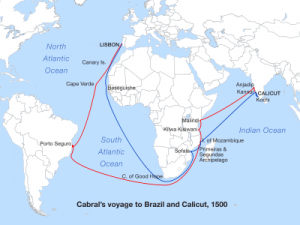
We then discussed Cabral’s voyage. His sea route to India was by going around Africa.
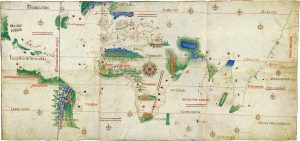
Cantino Planisphere (1502)
People have been trying to base maps on coast lines. The north/south directions are more accurate than the west/east dimensions. His mission is much more prepared. We then discussed the similarities and differences between Columbus and Cabral first reports back to the motherland. Cabral is selling it and Columbus is more on the fascination of body paint of the Natives. Portugal is interested in sending Jesuits for missionaries and they were interested in Brazil for only a port. Portugal saw Native People as “rulable” and docile. They thought they were doing a good by spreading the one true faith.
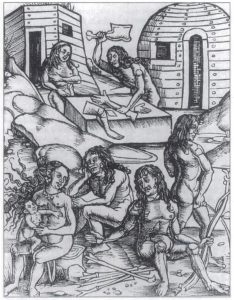
German Illustration of Amerigo Vespucci Letter
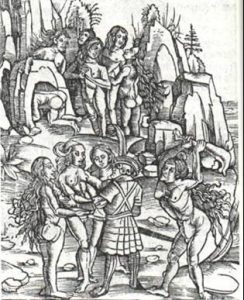
These were the first wildly circulated of new world people. Is it important to remember the artist has never left Germany and based his illustrations on Vespucci’s letter.
Class Discussion
- very sexualized drawing of Native women
- Limbs are on the cutting block to show cannibalism, barbarism, and violence.
- Posture is a strong motif in the drawing
- Natives are slouched and Europeans are standing tall
- Facial expressions seem primitive
- The depiction of Native Women is a Eurocentric view of women being more prone to sin
We ended the class with a self-evaluation of our class participation.
Inca Education Critique
The article I have chosen is about the divisions of Inca education and Inca education is general. The article is fairly short with two sub headings. My strongest critique is the article has no cited sources, which is extremely odd due to it being apart of two WikiProjects: Indigenous People of the Americas and Peru.
On the Talk Page, people from all the way back to 2006 have commented on the lack of sources, but no one has added anything. This tells me this page is not visited frequently and is an important reason why there are WikiProjects for the Indigenous People of the Americas and Peru. There are about only three comments on the talk page, and they only involve the lack of sources.
It seems that the article is neutral, but once again, it is difficult to gauge that without the sources. With that being said, the ideas within the article are neither under or over represented. However, there are a few phrases/words that could be linked to other articles, but they are just bolded, so it is difficult to find out more about Inca education.
With the lack of sources, the article should essentially not be trusted. However, it is a decent article with decent information.
Sao Paulo’s 28th Short Film Festival
Sao Paulo’s 28th Film Festival, also know as Mostra, is seeing an influx of film entries and films shown about and by Indigenous people, Afro-Brazilians, and women. TeleSur, a Venezuelan based news network, puts Indigenous people’s, Afro-Latinxs’, and women’s struggles as the focal points of many of their articles. Due to many films festivals’ lack of inclusion in their entries and showings, Telesur highlights Sao Paulo’s 28th Film Festival due to their “sharp increase in Indigenous, Afro-Brazilian and feminist film productions, ” something that has been very difficult for them since in 2000 when the festival had an open call for films produced by women and a minuscule amount was received. The festival will run until September 3.
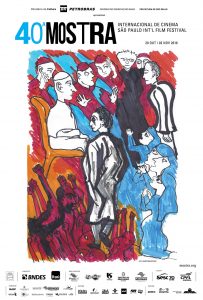
The 2016 poster for Sao Paulo’s Film Festival.
Not only are the films from marginalized groups, but they also depict an array of issues involved in these communities. One film series, “Empoderadas,” made by a directorfrom the Association of Black Audiovisual Professionals, deals with issues of racism and machismo, issues that run deep in Latinx communities around the globe. Artistic content by minorities groups is celebrated more and more each day as larger groups become aware of issues in their communities and stop brushing off content created by these groups.
A trailer for short film documentary, Sex, Sermons, and Politics by Aude Chevalier-Beaumel and Michael Gimenez.
This article deals with the intersectionality of the class, especially as we are currently learning about Indigenous groups and the erasure of their history and culture once the Europeans invaded. A big reason for the dismissal of issues and work created by Indigenous people, Afro-Latinx, and women is a consequence of European conquest and the Eurocentric culture that follows. It is important for us to critique whitewashed history and media and make minority groups’ history and content accessible to all.
https://www.telesurtv.net/english/news/Brazil-Short-Film-Festival-Sees-Increase-in-Indigenous-Films–20170823-0027.html
http://40.mostra.org/en/filme/8698-SEX,-SERMONS-AND-POLITICS
